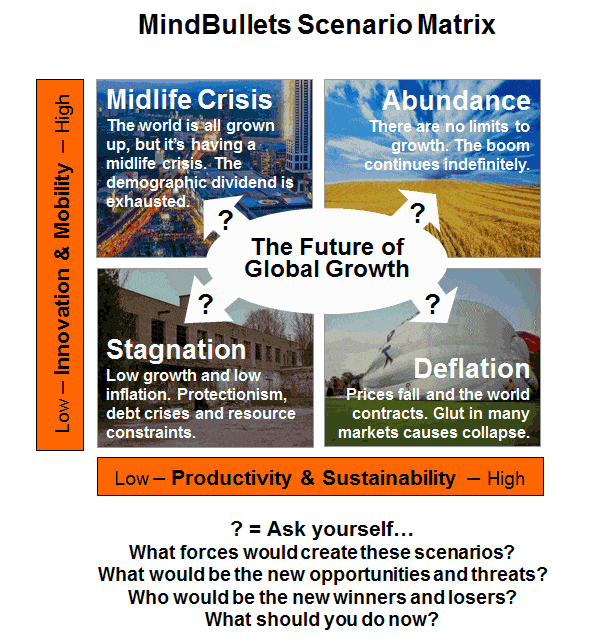
Stop the world, we’re having a midlife crisis

The West deflates, China stagnates, and the rest of the world watches and worries
- Dateline
- 1 May 2040
As the 21st Century approaches middle age, prices are falling alarmingly. In real terms, everything from coal to electronics is cheaper than it was four decades ago, and steel is at its lowest price in 100 years. Deflation is the norm in the Old World, and the so-called Dynamic Markets are no longer so dynamic.
Over the past century, we have seen global growth on an unprecedented scale, and average income per capita, worldwide, has never been higher. The economic superpowers of the previous century, particularly Europe and Japan, have taken a knock, but the rise of previously ‘Third World’ countries has more than balanced the scales.
The world’s population is expected to peak this year, as fertility rates continue to drop. That’s great for sustainability, but not so good for economic growth. Now we are faced with the situation where the whole world is mature. Middle class is the mean, and although pockets of poverty remain, globalization and mobility of resources have evened things out.
Despite all predictions to the contrary, the United States is still the biggest economy, but deflation is having a stultifying effect. The psyche of the nation is somewhat depressive, and America is no longer the land of boundless opportunity. Immigration is drying up, and consumer demand is falling. The US economy is utterly dependent on Canada, Mexico and China; and it’s a two-way street.
China has had the most dramatic transformation, from an agrarian subsistence economy to an industrial and political powerhouse, and the world’s banker. After decades of roller-coaster growth and development, China is urbanized, aging and running out of steam. China’s expansion into Africa, Latin America and Europe is also meeting with more resistance, stirring up accusations of anti-competitive behaviour.
It’s not all bad news though. Along with low prices, most countries now have many free essential services, including mobile telecoms, basic banking and LED lighting. Radical innovation in technology, especially bioengineering and additive manufacturing, transformed the global economy and fuelled the last super-boom. But the tide has turned, once again.
How will we shake off this perennial funk that seems to have overcome society? Can we engineer another global recovery? Are there limits to growth, or can we grasp the age of abundance?
ANALYSIS >> SYNTHESIS: How this scenario came to be
Forces driving the future
It’s 40 years since the DotCom bubble and more than three decades since the Financial Crisis. The world is a very different place in 2040, but not that surprising compared to 2020. The fundamental trends were already in evidence by 2015.
Population and demographics
Falling fertility rates and the rise of the global middle class made it inevitable that the world population would plateau around 2040. For some countries, like Italy and Japan, population growth was flat by 2010 and in decline by 2015. Dynamic economies like Mexico and Turkey, whose populations were stabilizing, reaped a demographic dividend, as the majority of people were of working age, with fewer children and dependents. More mature populations, by contrast, experienced a demographic penalty, with large numbers of older people and insufficient new entrants to the labour force.
Radical innovation in biotech, nanotech, infotech and additive manufacturing
Rapid advances in technology have created a virtuous circle, with ideas spawning better ideas, and affecting every industry from energy and resources to manufacturing, healthcare, consumer goods and logistics. The very basis of life, work, and social interaction has changed forever.
Globalization and mobility of resources, capital, labour and ideas
The world is flat. Everything is mobile. Ideas and value chains transcend national, geographic and cultural boundaries. Economies are mutually dependent on each other, and any attempt at insularity or protectionism means that we all suffer.
Sustainability and resource depletion and development
Beyond climate change, the choices we make in the development and depletion of resources, and the curation of the natural environment, continue to weigh heavily on our ability to support sustainable growth. Technology innovation adds to the complexity of these choices.
Pervasive communication and global co-operation
We’re all connected now. We have no choice but to acknowledge our interdependence. Global communication at the speed of thought, with rich interactive media, means that all the information is everywhere, all the time and on demand. Some see this as the emergence of a ‘global mind’.
Productivity and economic reform
With its roots in the first decade of this century, a growing need for new ways to conduct business, seeking mutual benefit and delivering value to all participants, not just the elite, has emerged. There’s no single model, and we don’t have a name for it, but it’s not the turbo-capitalism of the last century – and it seems to be working.
These forces driving the future, ebb and flow. It’s not a smooth ride. Population growth and demographics are largely beyond our control and fairly predictable. Pervasive communication is also a given, and won’t be going backwards. The strength of the remaining four drivers and our choices affecting them, determine the future of global growth.
2016: Mini boom
China’s steady demand for automobiles and oil has been a key ingredient of the recovery, following the Financial Crisis of 2009. New gas and oil developments in the Americas are keeping that region buoyant, even as Africa begins to rise. There’s a global boom as the Dow Jones and Hang Seng indices peak together. Only Europe, still trying to shake off the Euro debt crisis, seems off-colour.
2020: Taking a breather
The mini boom has fizzled out. Things are still pretty good, worldwide, and nobody’s calling it a recession, but the unbridled exuberance of 2016 has evaporated. Stock markets are off their peak, and housing is easing up. The US is almost independent of foreign oil, excluding Canada. Middle East oil prices begin to waver, but the Gulf States have already achieved dominance in global transport and logistics, with the cheapest airlines and shipping hubs in the world.
2030: Whizz bang boom
Millennials are now in their mid to late 30s; they have formed the new establishment. Their entrepreneurial spirit and educated, diverse ranks are adopting and developing technology at an unprecedented rate. Digital communication has turbo-charged technology innovation, and all industries are affected.
Biotech and nanotech are redefining business; energy efficiencies are going up, and real costs are coming down. There is an explosion of ultra-high-tech startups and mega businesses. “We don’t look for jobs – we create businesses and networks of value!” says one young self-starter.
Medicine has given way to genetic repair. Food production is a scientific process, and much of it takes place in cities. Additive manufacturing is maturing, and almost anything can be printed.
2040: Midlife crisis
The tech boom of the 21st Century has transformed the world, again; but now it’s running out of steam. Consumer demand in the biggest economies is sagging, and the population demographics are no longer fueling global growth. The human species has reached its maximum plateau, and although it will endure at this level, possibly for decades, it will never go higher.
Prices in the United States are softening like a leftover party balloon. China has not overtaken the US, and probably never will. Latin America is the new American dream. Africa has settled into its middle class role. The world feels middle-aged. Is it a global midlife crisis?

Links to related stories
- Fast Future: How the Millennial Generation Is Shaping Our World - David D. Burstein
- 2052 - A Global Forecast for the Next Forty Years - Jorgen Randers
- The Future - Al Gore
- US economy hit by deflation - A Gary Shilling, Business Report, 2 April 2013
- Gary Shilling Is Confused: There's No Global 'Deflation' To Speak Of - Forbes, 27 March 2013
Warning: Hazardous thinking at work
Despite appearances to the contrary, Futureworld cannot and does not predict the future. Our Mindbullets scenarios are fictitious and designed purely to explore possible futures, challenge and stimulate strategic thinking. Use these at your own risk. Any reference to actual people, entities or events is entirely allegorical. Copyright Futureworld International Limited. Reproduction or distribution permitted only with recognition of Copyright and the inclusion of this disclaimer.